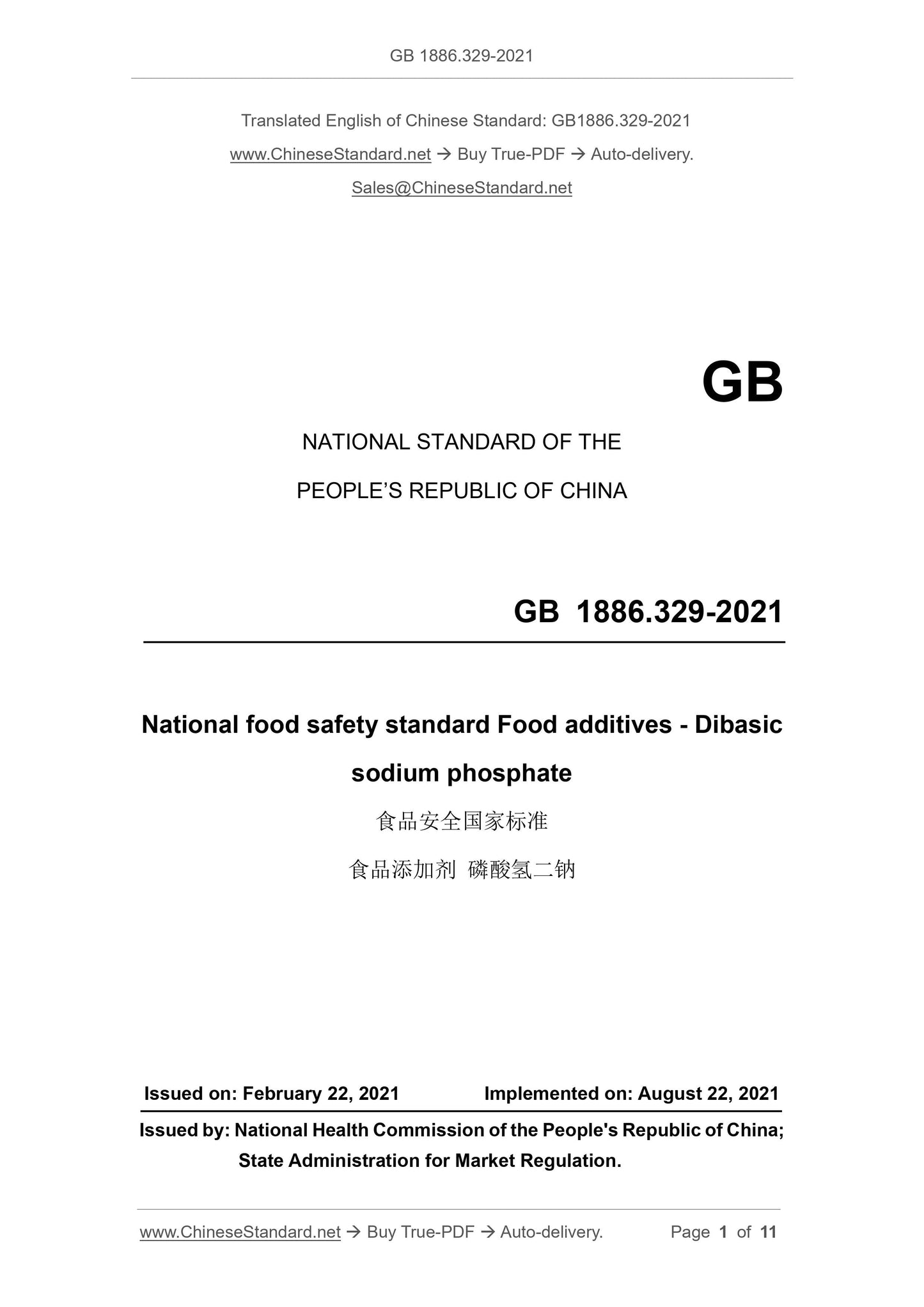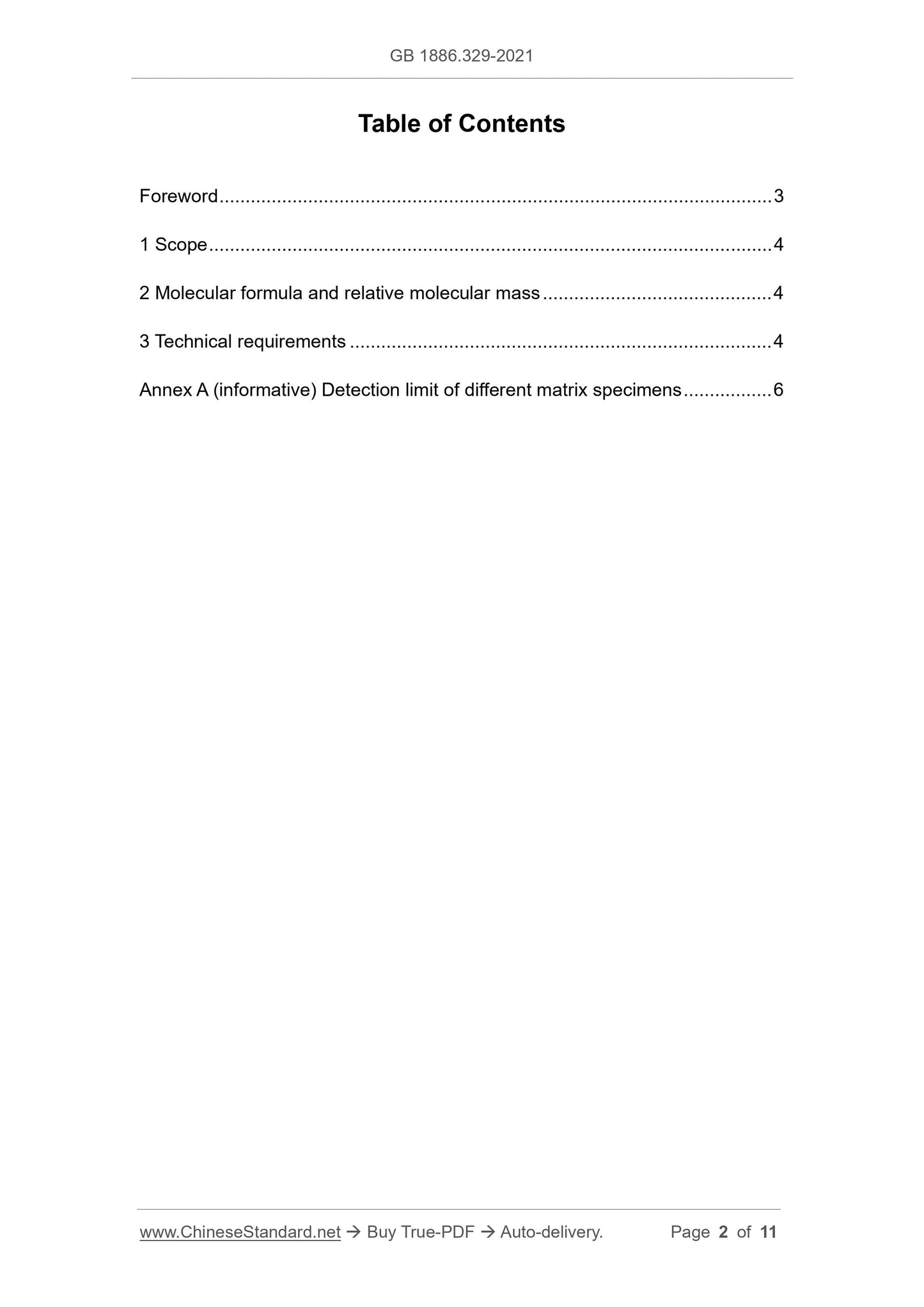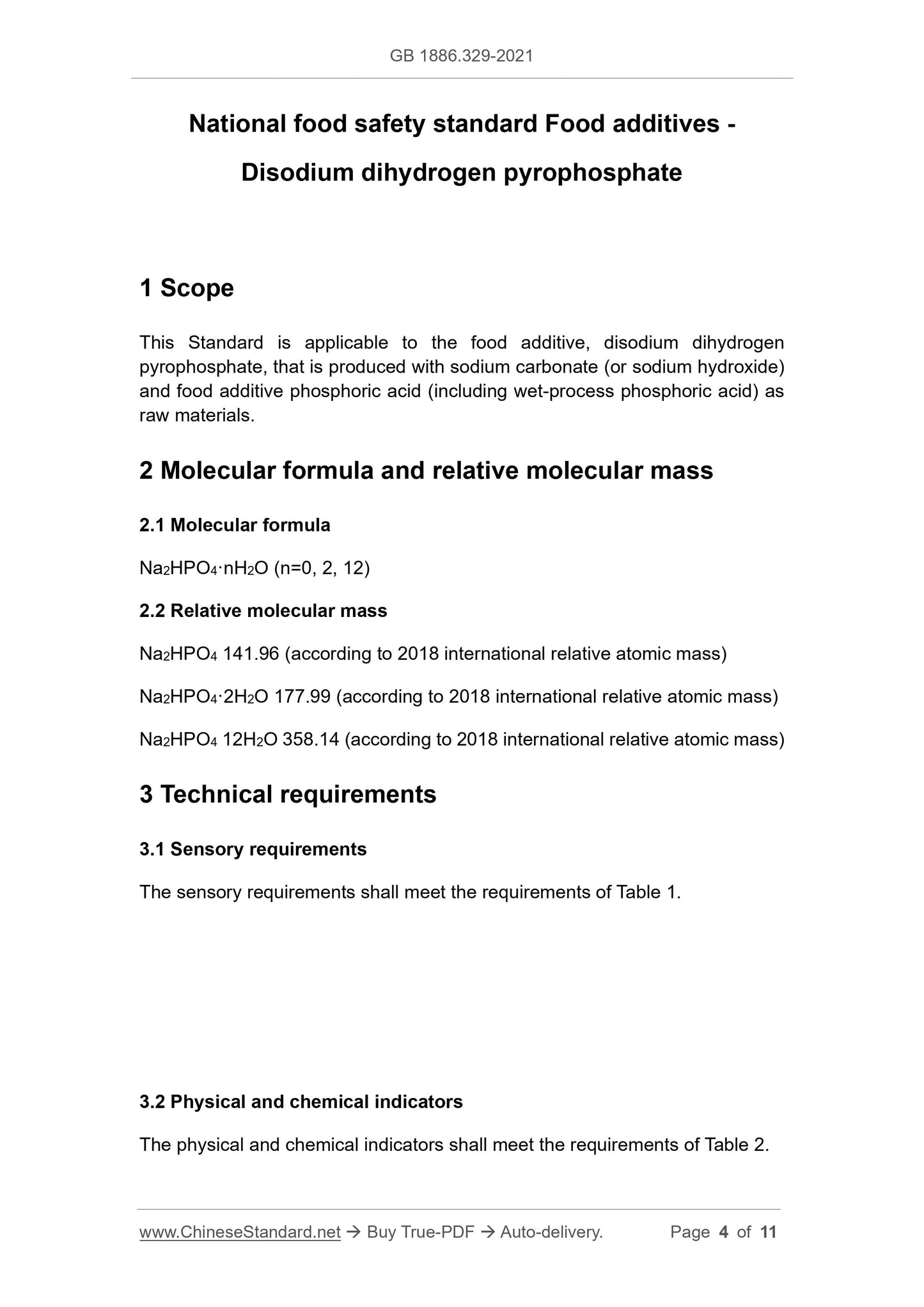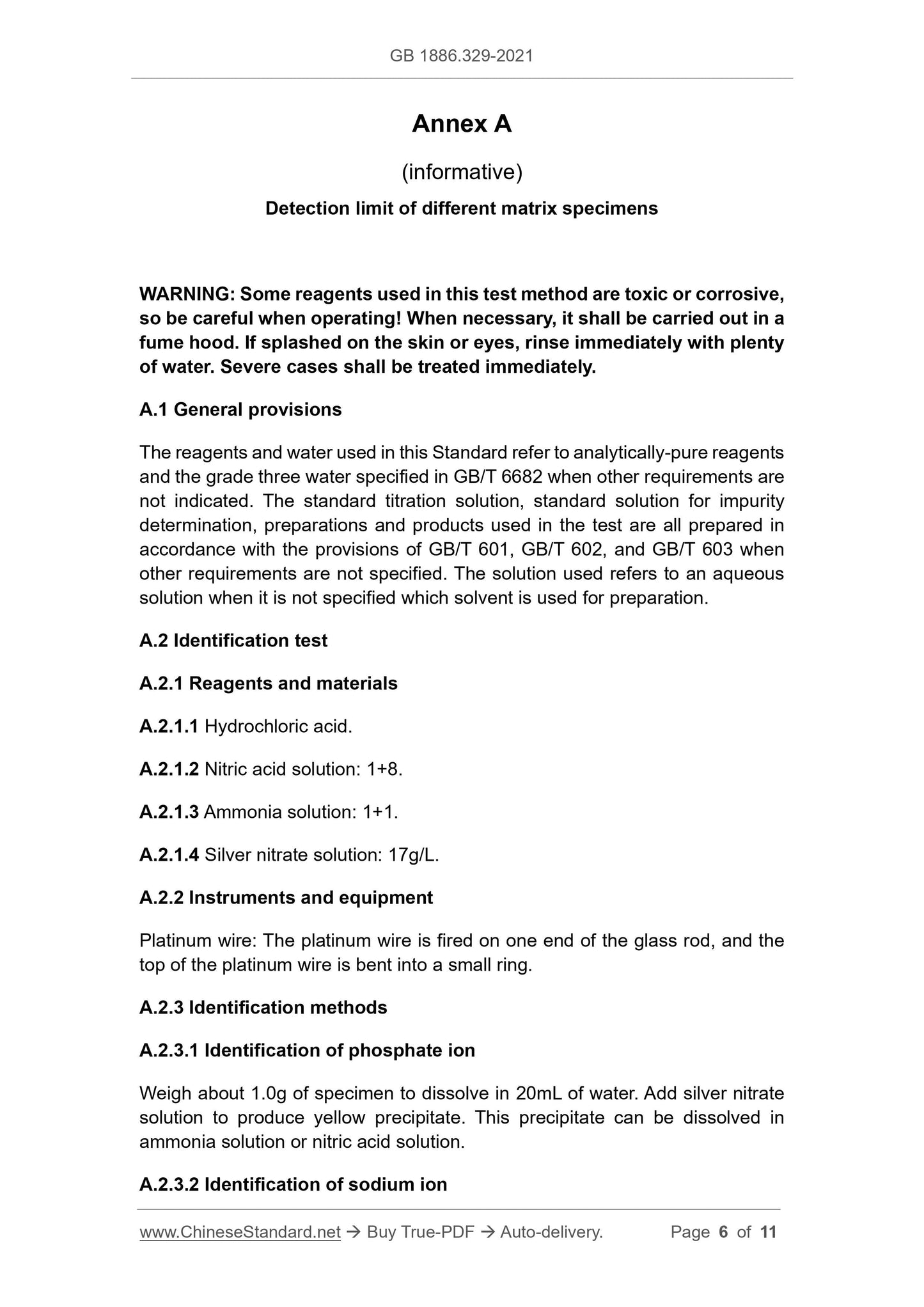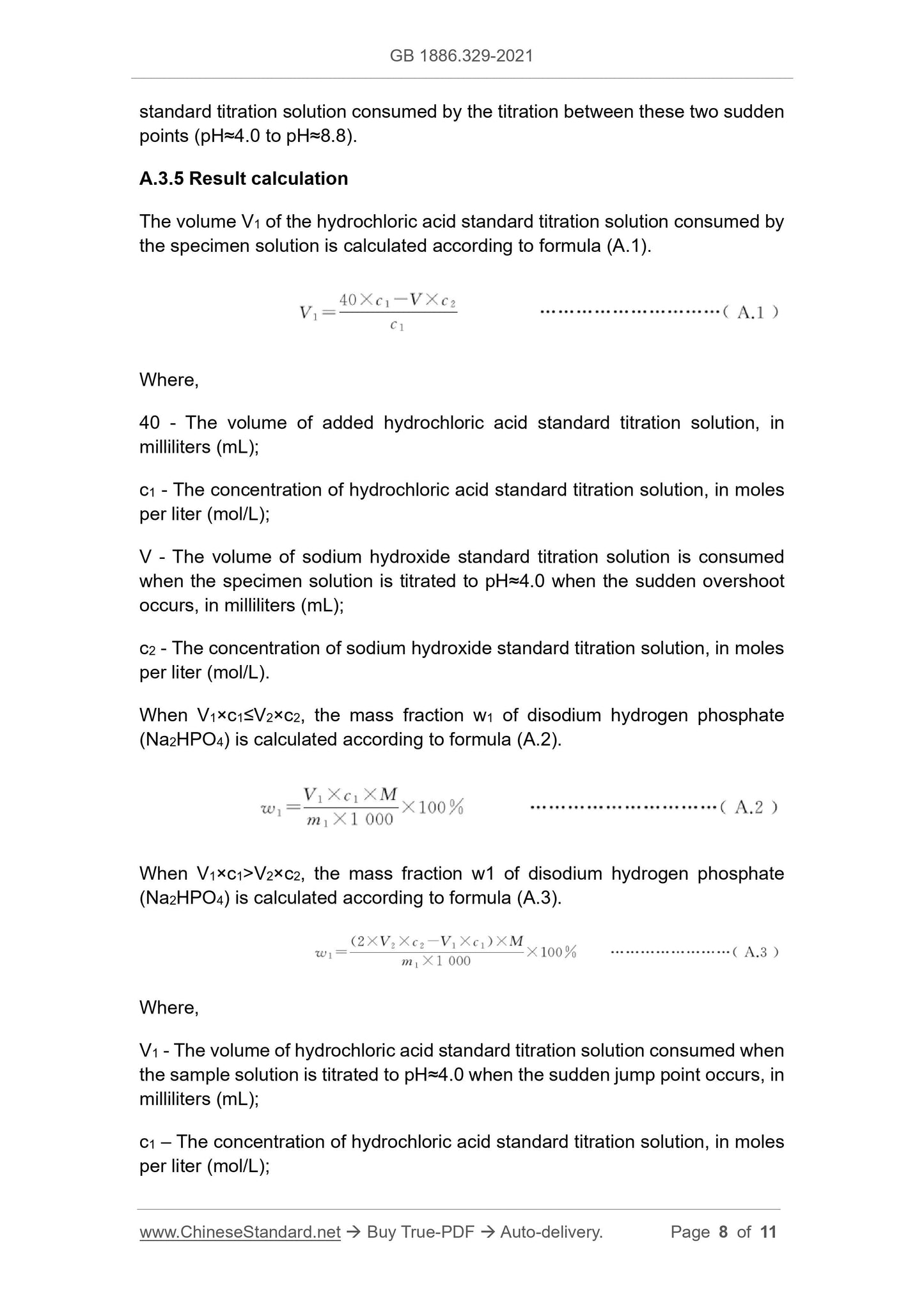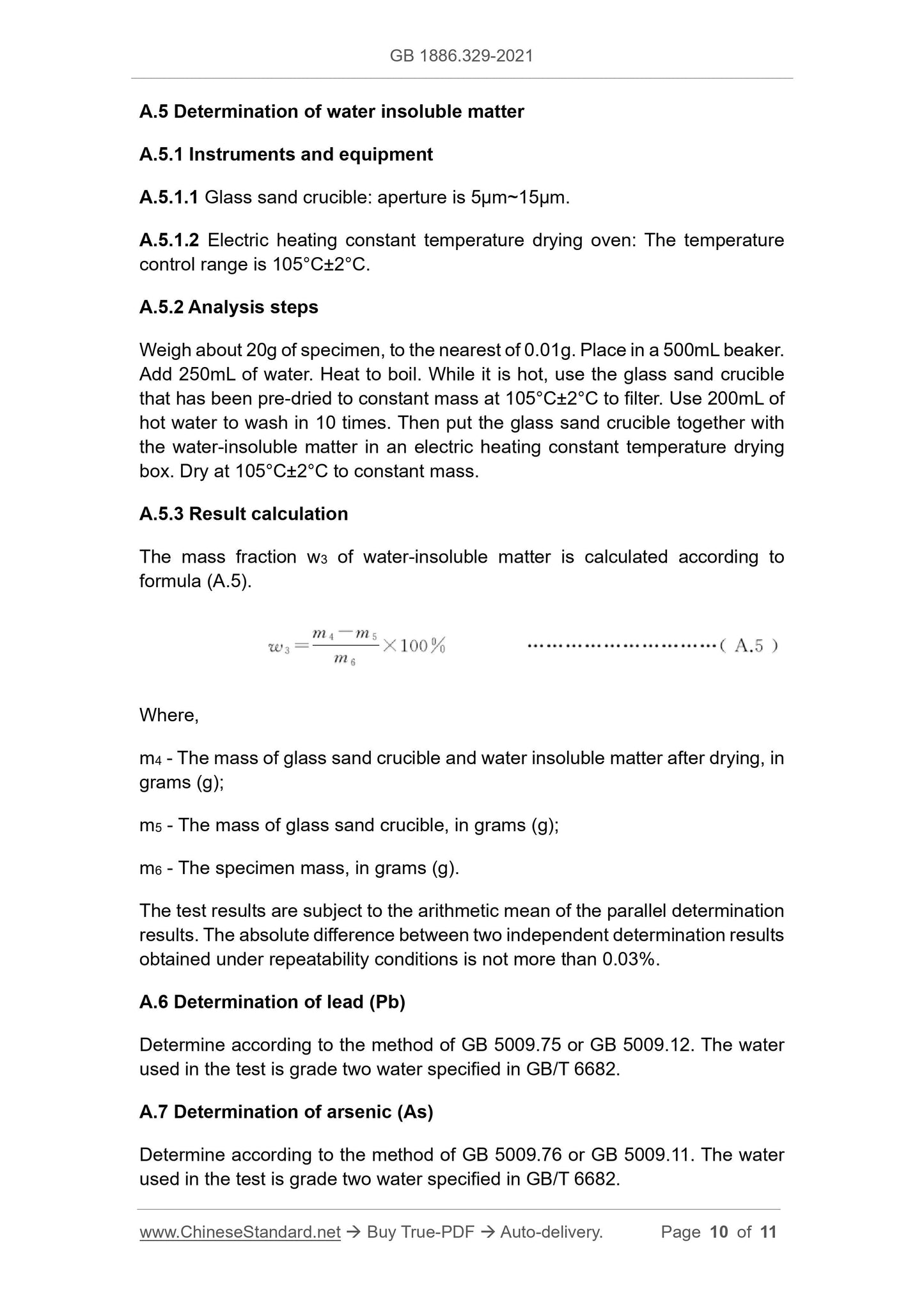1
/
of
6
PayPal, credit cards. Download editable-PDF & invoice in 1 second!
GB 1886.329-2021 English PDF (GB1886.329-2021)
GB 1886.329-2021 English PDF (GB1886.329-2021)
Regular price
$125.00 USD
Regular price
Sale price
$125.00 USD
Unit price
/
per
Shipping calculated at checkout.
Couldn't load pickup availability
Delivery: 3 seconds. Download true-PDF + Invoice.
Get QUOTATION in 1-minute: Click GB 1886.329-2021
Historical versions: GB 1886.329-2021
Preview True-PDF (Reload/Scroll if blank)
GB 1886.329-2021: National food safety standard - Food additives - Dibasic sodium phosphate
GB 1886.329-2021
GB
NATIONAL STANDARD OF THE
PEOPLE’S REPUBLIC OF CHINA
National food safety standard Food additives - Dibasic
sodium phosphate
食品添加剂 磷酸氢二钠
ISSUED ON: FEBRUARY 22, 2021
IMPLEMENTED ON: AUGUST 22, 2021
Issued by: National Health Commission of the People's Republic of China;
State Administration for Market Regulation.
Table of Contents
Foreword ... 3
1 Scope ... 4
2 Molecular formula and relative molecular mass ... 4
3 Technical requirements ... 4
Annex A (informative) Detection limit of different matrix specimens ... 6
National food safety standard Food additives -
Disodium dihydrogen pyrophosphate
1 Scope
This Standard is applicable to the food additive, disodium dihydrogen
pyrophosphate, that is produced with sodium carbonate (or sodium hydroxide)
and food additive phosphoric acid (including wet-process phosphoric acid) as
raw materials.
2 Molecular formula and relative molecular mass
2.1 Molecular formula
Na2HPO4·nH2O (n=0, 2, 12)
2.2 Relative molecular mass
Na2HPO4 141.96 (according to 2018 international relative atomic mass)
Na2HPO4·2H2O 177.99 (according to 2018 international relative atomic mass)
Na2HPO4 12H2O 358.14 (according to 2018 international relative atomic mass)
3 Technical requirements
3.1 Sensory requirements
The sensory requirements shall meet the requirements of Table 1.
3.2 Physical and chemical indicators
The physical and chemical indicators shall meet the requirements of Table 2.
Annex A
(informative)
Detection limit of different matrix specimens
WARNING: Some reagents used in this test method are toxic or corrosive,
so be careful when operating! When necessary, it shall be carried out in a
fume hood. If splashed on the skin or eyes, rinse immediately with plenty
of water. Severe cases shall be treated immediately.
A.1 General provisions
The reagents and water used in this Standard refer to analytically-pure reagents
and the grade three water specified in GB/T 6682 when other requirements are
not indicated. The standard titration solution, standard solution for impurity
determination, preparations and products used in the test are all prepared in
accordance with the provisions of GB/T 601, GB/T 602, and GB/T 603 when
other requirements are not specified. The solution used refers to an aqueous
solution when it is not specified which solvent is used for preparation.
A.2 Identification test
A.2.1 Reagents and materials
A.2.1.1 Hydrochloric acid.
A.2.1.2 Nitric acid solution: 1+8.
A.2.1.3 Ammonia solution: 1+1.
A.2.1.4 Silver nitrate solution: 17g/L.
A.2.2 Instruments and equipment
Platinum wire: The platinum wire is fired on one end of the glass rod, and the
top of the platinum wire is bent into a small ring.
A.2.3 Identification methods
A.2.3.1 Identification of phosphate ion
Weigh about 1.0g of specimen to dissolve in 20mL of water. Add silver nitrate
solution to produce yellow precipitate. This precipitate can be dissolved in
ammonia solution or nitric acid solution.
A.2.3.2 Identification of sodium ion
standard titration solution consumed by the titration between these two sudden
points (pH≈4.0 to pH≈8.8).
A.3.5 Result calculation
The volume V1 of the hydrochloric acid standard titration solution consumed by
the specimen solution is calculated according to formula (A.1).
Where,
40 - The volume of added hydrochloric acid standard titration solution, in
milliliters (mL);
c1 - The concentration of hydrochloric acid standard titration solution, in moles
per liter (mol/L);
V - The volume of sodium hydroxide standard titration solution is consumed
when the specimen solution is titrated to pH≈4.0 when the sudden overshoot
occurs, in milliliters (mL);
c2 - The concentration of sodium hydroxide standard titration solution, in moles
per liter (mol/L).
When V1×c1≤V2×c2, the mass fraction w1 of disodium hydrogen phosphate
(Na2HPO4) is calculated according to formula (A.2).
When V1×c1>V2×c2, the mass fraction w1 of disodium hydrogen phosphate
(Na2HPO4) is calculated according to formula (A.3).
Where,
V1 - The volume of hydrochloric acid standard titration solution consumed when
the sample solution is titrated to pH≈4.0 when the sudden jump point occurs, in
milliliters (mL);
c1 – The concentration of hydrochloric acid standard titration solution, in moles
per liter (mol/L);
A.5 Determination of water insoluble matter
A.5.1 Instruments and equipment
A.5.1.1 Glass sand crucible: aperture is 5μm~15μm.
A.5.1.2 Electric heating constant temperature drying oven: The temperature
control range is 105°C±2°C.
A.5.2 Analysis steps
Weigh about 20g of specimen, to the nearest of 0.01g. Place in a 500mL beaker.
Add 250mL of water. Heat to boil. While it is hot, use the glass sand crucible
that has been pre-dried to constant mass at 105°C±2°C to filter. Use 200mL of
hot water to wash in 10 times. Then put the glass sand crucible together with
the water-insoluble matter in an electric heating constant temperature drying
box. Dry at 105°C±2°C to constant mass.
A.5.3 Result calculation
The mass fraction w3 of water-insoluble matter is calculated according to
formula (A.5).
Where,
m4 - The mass of glass sand crucible and water insoluble matter after drying, in
grams (g);
m5 - The mass of glass sand crucible, in grams (g);
m6 - The specimen mass, in grams (g).
The test results are subject to the arithmetic mean of the parallel determination
results. The absolute difference between two independent determination results
obtained under repeatability conditions is not more than 0.03%.
A.6 Determination of lead (Pb)
Determine according to the method of GB 5009.75 or GB 5009.12. The water
used in the test is grade two water specified in GB/T 6682.
A.7 Determination of arsenic (As)
Determine according to the method of GB 5009.76 or GB 5009.11. The water
used in the test is grade two water specified in GB/T 6682.
Get QUOTATION in 1-minute: Click GB 1886.329-2021
Historical versions: GB 1886.329-2021
Preview True-PDF (Reload/Scroll if blank)
GB 1886.329-2021: National food safety standard - Food additives - Dibasic sodium phosphate
GB 1886.329-2021
GB
NATIONAL STANDARD OF THE
PEOPLE’S REPUBLIC OF CHINA
National food safety standard Food additives - Dibasic
sodium phosphate
食品添加剂 磷酸氢二钠
ISSUED ON: FEBRUARY 22, 2021
IMPLEMENTED ON: AUGUST 22, 2021
Issued by: National Health Commission of the People's Republic of China;
State Administration for Market Regulation.
Table of Contents
Foreword ... 3
1 Scope ... 4
2 Molecular formula and relative molecular mass ... 4
3 Technical requirements ... 4
Annex A (informative) Detection limit of different matrix specimens ... 6
National food safety standard Food additives -
Disodium dihydrogen pyrophosphate
1 Scope
This Standard is applicable to the food additive, disodium dihydrogen
pyrophosphate, that is produced with sodium carbonate (or sodium hydroxide)
and food additive phosphoric acid (including wet-process phosphoric acid) as
raw materials.
2 Molecular formula and relative molecular mass
2.1 Molecular formula
Na2HPO4·nH2O (n=0, 2, 12)
2.2 Relative molecular mass
Na2HPO4 141.96 (according to 2018 international relative atomic mass)
Na2HPO4·2H2O 177.99 (according to 2018 international relative atomic mass)
Na2HPO4 12H2O 358.14 (according to 2018 international relative atomic mass)
3 Technical requirements
3.1 Sensory requirements
The sensory requirements shall meet the requirements of Table 1.
3.2 Physical and chemical indicators
The physical and chemical indicators shall meet the requirements of Table 2.
Annex A
(informative)
Detection limit of different matrix specimens
WARNING: Some reagents used in this test method are toxic or corrosive,
so be careful when operating! When necessary, it shall be carried out in a
fume hood. If splashed on the skin or eyes, rinse immediately with plenty
of water. Severe cases shall be treated immediately.
A.1 General provisions
The reagents and water used in this Standard refer to analytically-pure reagents
and the grade three water specified in GB/T 6682 when other requirements are
not indicated. The standard titration solution, standard solution for impurity
determination, preparations and products used in the test are all prepared in
accordance with the provisions of GB/T 601, GB/T 602, and GB/T 603 when
other requirements are not specified. The solution used refers to an aqueous
solution when it is not specified which solvent is used for preparation.
A.2 Identification test
A.2.1 Reagents and materials
A.2.1.1 Hydrochloric acid.
A.2.1.2 Nitric acid solution: 1+8.
A.2.1.3 Ammonia solution: 1+1.
A.2.1.4 Silver nitrate solution: 17g/L.
A.2.2 Instruments and equipment
Platinum wire: The platinum wire is fired on one end of the glass rod, and the
top of the platinum wire is bent into a small ring.
A.2.3 Identification methods
A.2.3.1 Identification of phosphate ion
Weigh about 1.0g of specimen to dissolve in 20mL of water. Add silver nitrate
solution to produce yellow precipitate. This precipitate can be dissolved in
ammonia solution or nitric acid solution.
A.2.3.2 Identification of sodium ion
standard titration solution consumed by the titration between these two sudden
points (pH≈4.0 to pH≈8.8).
A.3.5 Result calculation
The volume V1 of the hydrochloric acid standard titration solution consumed by
the specimen solution is calculated according to formula (A.1).
Where,
40 - The volume of added hydrochloric acid standard titration solution, in
milliliters (mL);
c1 - The concentration of hydrochloric acid standard titration solution, in moles
per liter (mol/L);
V - The volume of sodium hydroxide standard titration solution is consumed
when the specimen solution is titrated to pH≈4.0 when the sudden overshoot
occurs, in milliliters (mL);
c2 - The concentration of sodium hydroxide standard titration solution, in moles
per liter (mol/L).
When V1×c1≤V2×c2, the mass fraction w1 of disodium hydrogen phosphate
(Na2HPO4) is calculated according to formula (A.2).
When V1×c1>V2×c2, the mass fraction w1 of disodium hydrogen phosphate
(Na2HPO4) is calculated according to formula (A.3).
Where,
V1 - The volume of hydrochloric acid standard titration solution consumed when
the sample solution is titrated to pH≈4.0 when the sudden jump point occurs, in
milliliters (mL);
c1 – The concentration of hydrochloric acid standard titration solution, in moles
per liter (mol/L);
A.5 Determination of water insoluble matter
A.5.1 Instruments and equipment
A.5.1.1 Glass sand crucible: aperture is 5μm~15μm.
A.5.1.2 Electric heating constant temperature drying oven: The temperature
control range is 105°C±2°C.
A.5.2 Analysis steps
Weigh about 20g of specimen, to the nearest of 0.01g. Place in a 500mL beaker.
Add 250mL of water. Heat to boil. While it is hot, use the glass sand crucible
that has been pre-dried to constant mass at 105°C±2°C to filter. Use 200mL of
hot water to wash in 10 times. Then put the glass sand crucible together with
the water-insoluble matter in an electric heating constant temperature drying
box. Dry at 105°C±2°C to constant mass.
A.5.3 Result calculation
The mass fraction w3 of water-insoluble matter is calculated according to
formula (A.5).
Where,
m4 - The mass of glass sand crucible and water insoluble matter after drying, in
grams (g);
m5 - The mass of glass sand crucible, in grams (g);
m6 - The specimen mass, in grams (g).
The test results are subject to the arithmetic mean of the parallel determination
results. The absolute difference between two independent determination results
obtained under repeatability conditions is not more than 0.03%.
A.6 Determination of lead (Pb)
Determine according to the method of GB 5009.75 or GB 5009.12. The water
used in the test is grade two water specified in GB/T 6682.
A.7 Determination of arsenic (As)
Determine according to the method of GB 5009.76 or GB 5009.11. The water
used in the test is grade two water specified in GB/T 6682.
Share
